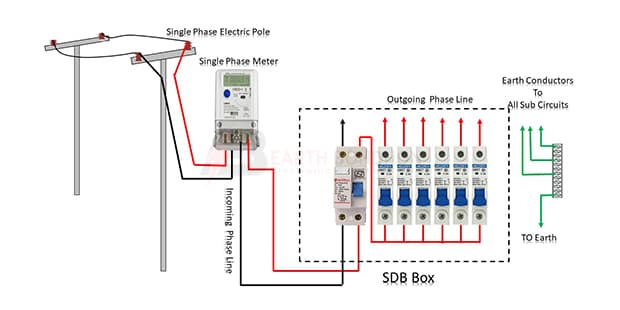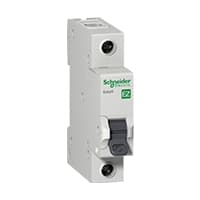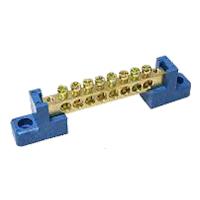Single Phase Meter Connection:
This diagram shows how to make Single Phase Meter Connection. In this circuit, we use a single-phase energy meter, a DP MCB ( Double Pole Miniature Circuit Breaker ), six SP MCBs ( Single Pole Miniature Circuit Breaker ), and an earthing busbar. First, we need to input a power line into the energy meter. Then input phase line to DP MCB from the meter, then the input phase line to all SP MCB from the DP MCB. Now this circuit is ready for use. If you want to know more about this circuit please check our youtube video below the post.
Advertisements
Components needed For this Project:
You can get the components from any of the sites below:
- Single Phase Energy Meter [See Buy Click Amazon]
- DP MCB 32A [See Buy Click Amazon]
- SP MCB 10A [See Buy Click Amazon]
- Busbar wire [See Buy Click Amazon]
*Please note: These are affiliate links. I may make a commission if you buy the components through these links. I would appreciate your support in this way!
Advertisements
Components used to make the Single Phase Meter Connection:
A Single-Phase Energy Meter is a sort of Watt-Hour meter. It consists of two Electromagnets. Single-Phase Energy Meter is also Popularly known as a watt-hour meter. 1 Magnet is called the shunt magnet Ml which is Mounted with a Pressure coil. The Pressure coil is a long coil Made of fine Copper wire that is connected across the Supply single-phase line. Single-phase energy meters are suitable for measuring single-phase AC current flow frequencies of 50/60 Hz, which are used for fixed indoor installation systems.
02. DP MCB:
DP MCB In 2 Pole MCB, switching & protection is affected in phases and the neutral. A Double Pole or DP Switch is a Switch that Controls 2 Circuits at the same time. In terms of Residential Switching, this Normally means it Switches the live and Neutral at the same time. In Layperson Terms, Double Pole switches or DP Switches are Exclusively Designed to Control 2 Different Electrical Circuits at the same time, which allows the Appliances to Isolate safely and reliably. Fan or light Combinations and Medical Equipment are some of the many applications for DP Electrical Switches and Electrical components.
In single-pole MCB, Switching and protection are Affected in only one Phase. Single phase supply to break the phase only. A single Pole breaker is Typically used with 120-volt Circuits, and a 6-20 amps Miniature Circuit Breaker. They are constructed with one Line Wire and one Neutral wire. A Single Pole switch is the most basic General-Purpose switch that you use to Control a light or another device from one location. These Switches have 2 Brass-Colored screw Terminals Connected to the hot Power source wires. Pole refers to the number of Circuits Controlled by the Switch SP Switches Control only one Switch Electrical Circuit.
04. Busbar:
A busbar is a type of Electrical conductor. It is made of copper brass or aluminum. Busbar is most commonly used in factories. We supply the power from the transformer to the busbar. We take the electricity from this busbar to the circuit breaker. The advantage of using a busbar is that through it we can provide multiple power connections in multiple places very easily. How many thick copper bars are aggregates of busbars? A copper bar is rectangular (rectangular) copper type or triangular in shape.
Thank You for visiting the website. Keep visiting for more Updates.
Frequently asked questions
A single-phase meter also referred to as a credit meter, KWh meter, or check meter are electrical meter designed for use in measuring the power consumption in a single-phase power supply. These meters, however, only deal with the Alternating current (AC power) supply and not the Direct current (DC) power.
A single-phase air conditioner uses a single-phase power supply, with single-phase being the circuit diagram standard method of the distribution of electric power supply in lighting and heating. 3-phase air conditioners require a 3-phase power supply and are generally used for models with larger heating/cooling capacity.
A single-phase charge point uses a standard 230 V connection and has 16 A or 32 A current per power supply socket. So, the maximum charging capacity per power supply socket is 7.4 kW (with 16 A, you get 3.7 kW). A single-phase connection is the power supply minimum everyone has, so you certainly have one as well!
To calculate single-phase power (P) in an electrical circuit, you can use the formula P = V * I * cos(θ), where V is the voltage, I is the current, and cos(θ) is the power factor. This formula takes into account the voltage, current, and phase angle between the voltage and current waveforms.
In electrical and engineering, a single-phase electric power supply (abbreviated 1φ) is the distribution of alternating current electric power supply using a system in which all the voltages of the supply vary in unison. Single-phase and distribution are used when loads are mostly lighting and heating, as with few large electric motors.
Read more Single Phase Wiring
What is a kilowatt-hour (kWh) | kwh formula | What does kwh mean
Introduction to Electrical Units and CircuitskW and kWh on your electricity bill As your home uses electricity during...
What is the Difference Between kVA | What does KVA mean | kVA formula
Difference Between KVA ExplainedWhat does KVA Mean? There are technical terms aplenty when it comes to generators, and...
Power Factor | Power Unit | Energy | Electricity Unit
Power factor definition | Calculating Power FactorPower Factor Values In a purely resistive circuit, the power factor...





0 Comments